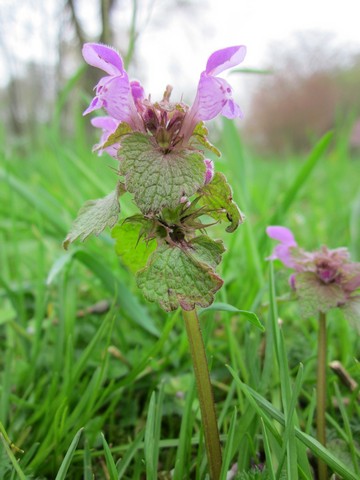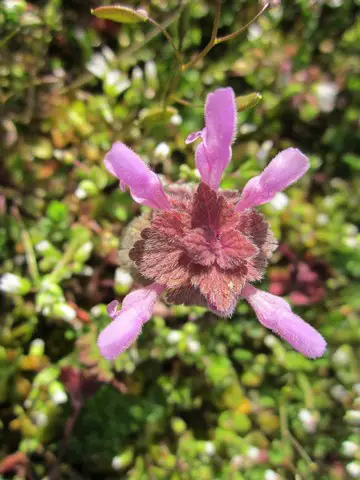Last Updated on November 26, 2021 by Grow with Bovees
Henbit — the name comes from the fact that hens like to eat it — is a fuzzy little perennial weed with purple flowers that grow from buds attached to a green to purple square-shaped stem.
It has branching roots and pretty purple flowers.
This sturdy plant with shallow roots typically grows 5 to 11 inches tall and has deep green heart-shaped leaves with scalloped edges that have deep lobes on the underside.
There are a few that come from the mint family, namely wild violets and ground ivy.
The Difference Between Purple Flowered Weeds — Wild Violet, Henbit & Purple Deadnettle
Because they are both in the mint family, they look similar. Both are a common weed and often grow in the same place at the same time, they can often be mistaken for one another.
However, at least both are fairly easily distinguishable from two other purple perennial weeds; wild violet and ground ivy (aka creeping charlie), both of which also have pretty light purple flowers.
Wild Violets
Wild violet weeds are lower growing and can also have yellow flowers. Wild violet flowers don’t have as many enemies as other lawn weeds, maybe because wild violets being edible and high in vitamin C and vitamin A, their dark green colored leaves of wild violets are often used in salads or used as a cooked green vegetable somewhat similar to spinach for their medicinal properties. Some people even deliberately plant them in their gardens.
Henbit
Henbit, (Lamium amplexicaule) is a perennial bloomer which has pink flowers or pretty purple flowers with purple spots and a yellow center.

The flowers of henbit are tubular and form at the end of delicate stems in a small spiral formation. Henbit has scalloped leaves that are rounded and have deep lobes and only the lower leaves have petioles.
Purple Deadnettle
Purple deadnettle, (Lamium purpureum) bright blooms are a lighter shade of purple and are fatter and shorter than those of henbit. The upper leaves coming from the upper stem are pointed with triangular tips and petioles, and are increasingly purple towards the upper stem. The purple-tinged leaves overlap and are also slightly fuzzier than those of henbit.

While we might love purple houseplants with purple blooms around the interior of our homes, we may not enjoy purple weeds all over our yard!
How Do You Treat Henbit — Pre-Blooms?
Carefully inspect your entire grass lawn to determine where and how extensive the weed is growing, how much of your lawn is covered, and the underlying reasons why you have it.
Where To Look
Henbit, invades thin and weak parts of lawns and turf grass, as do most common weeds, and is often found in shady garden areas of moist soil too, due to water not being evaporated efficiently.
They grow in sandy soil but prefer to grow in drainage ditches and moist soil where the turf has been damaged or stressed.
You will not be looking for purple flowers at this point. In fact, inspection should take place before early spring comes around. Killing the henbit before the blooms appear in late spring, is of high importance as this is the one way of stopping seed production.
Waiting too long to get rid of the henbit risks it spreading and getting out of control, developing mats of leaves, which, as when trying to control dandelions, another summer annual difficult weed, may result in it taking years to eradicate and getting your lawn back to a healthy state.
Henbit is quite sensitive to warm weather, and it will start to wilt/wither in the hot summer temperatures. Therefore, germination of new weed seeds begins in late summer.
When plants are small and without flowers, they are easily missed, especially in an otherwise thick and healthy lawn, but, with careful inspection, they can be identified and dealt with. This is also the ideal time to try and deal with them, as they are not as tough at this stage.
Purple Weed Removal Method
If weeds with purple flowers grow in flower beds and entire landscape beds, the entire plant can just be removed by hand pulling using a weed puller tool which gets right down to the underground stems and root system, and then mulch can be spread which will serve to suppress growth. You can also cut them using a grass whip, or weed whip tool. This is a very effective method.
In lawns and other areas where there are larger infestations, the most effective elimination method is to use a pre-emergent herbicide and apply it to the affected weed areas of the entire lawn at the same time.
Control Of Henbit In A Lawn
To control an aggressive weed, you will want to use organic methods in the form of dish soap or a ‘post-emergent non-selective herbicide’, so first, find out if you have warm or cool-season turf and then choose the appropriate post emergent weed control for broadleaf weeds and weed seed production.
After calculating the size of the area you need to cover, and following the mixing ratios on the product you have, you can mix the herbicide and water in a 1–1.5-gallon handheld or backpack sprayer.
Pump until you have a spritz of fine mist (it should be of relatively low pressure — you may need to adjust the nozzle to achieve the correct pressure). Continue spraying it on the weeds, and be careful not to spray the surrounding grass as much as possible, this can be quite damaging.
Spray an even coating over the rounded leaves until wet, but not soggy. The product should remain on the plants for as long as possible and not run off, be washed off, or be blown off. Also, make sure to use a pet-friendly weed killer product.
Check the weather beforehand, and try to do it on a rainless, windless day (or at least when winds are low speed) and when no rain is forecast for the following day.
You should see the affected weeds dying (wilting, going brown) around 2 weeks after applying the weed killer spray.
If you feel it is necessary, reapplication of the product can be done, but keep in mind that herbicides contain strong chemicals, and should be restricted to using them 2 times in a one-year period.
Be patient during this process and make sure to give it some time to work, over doing it may kill your grass.
How Do You Treat Henbit – Post Blooms?
Noticing the growth of henbit only after it has bloomed, calls for the use of a pre-emergence herbicide treatment. This means eliminating the chance for future plant growth rather than killing the existing weed.
Be sure to do this before surrounding temperatures become too cool, in order to prevent more seeds from sprouting. Germination for this winter annual weed occurs in early fall, so your pre-emergent treatment needs to be applied before this. Or else, before the ground gets cooler than 70 degrees F.
Usually, you can find out the average ground temperatures for your area to make planning this process a little easier.
This product forms a chemical herbicide barrier, which stops new and fresh seeds from sprouting. The best method to apply it is by spreading in parallel lines across the length of the lawn and then, at a perpendicular angle, parallel lines across the width. Always water the area when you are done.
How Do You Prevent Purple Flowering Weeds?
Have a gorgeous, lush, thick, and healthy lawn! Yay! Henbit is a lover, not a fighter. Your lawn being thick and healthy, will avoid the henbit fighting for it.
To achieve a thick and lush lawn, make sure you are mowing your lawn at the correct height and regularly feed it with lawn weed and feed every quarter. Rake your lawn regularly and trim back any overhanging shrubs or trees. This reduces moist shady patches in the garden, and improves air circulation, which will discourage most weeds.
Water around 1 to 1.5 inches per week. When there is no rainfall, this should translate to watering your lawn around once a week and preferably in the morning. This amount should be sufficient.
Fertilize regularly starting early spring with nitrogen, phosphorus, and potassium so that your lawn is strong, and harmful weeds can’t get a look in!
What Harm Do They Cause?
After going through all the trouble of removing emerging nasty weeds, you might ask yourself, why make the effort to pull out such beautiful flowering weeds.
The answer: weeds affect plants and may cause significant damage to surrounding plants and lawn.
Weeds Rob Soil Of Nutrients
Like other plants, weeds such as wild violet also put up a fight to survive. And they are quite good at doing that. In fact, they can completely rob your garden soil of vital nutrients, causing your existing plants and flowers and vegetables to stunt while the weed flourishes and takes over all your garden beds.
Many Weeds Are Invasive
These pesky plants, including wild violets, ground ivy, creeping charlie and purple dead nettle can quickly spread and overtake your garden if not dealt with in a timely manner.
They don’t only invade lawns or flower beds, but they will attack container plants as well. And in comparison to other mature plants, weeds are quite hardy survivors.
Depletion Of Water
During the growing season, we all know that our plants and vegetables are in need of good amounts of water.
They are resilient plants and will not hesitate to ‘share’ the water given to surrounding plants without limit soon depriving them of the moisture that they so desperately need.
Crowding Other Plants
There are a few weeds like purple dead nettle with vigorous growth that can grow to be tall and wide, vertically outgrowing other surrounding garden plants and eventually causing some problems.
Blocking Sunlight
All garden plants need at least a bit of sunshine in order to survive. Large weeds like wild violet, creeping charlie or ground ivy can shade other plants, blocking out the light that is required for healthy growth.
Blocking Airflow
Big amounts of ground ivy weeds may crowd other plants. This blocks the flow of air between the plants. Without sufficient air flow, the soil in your garden will struggle to dry out after a shower, for example.
Over time, while the soil stays too moist for too long, your plants and moist areas may become susceptible to diseases, mildew and molds.
Conclusion
Having mentioned all the above, please note that there are certain benefits to mint family weeds growing in your garden landscape or across a field. One example is helping control soil erosion. If you are landscaping on a slope, for instance, their aggressive growth can help to quickly stabilize the soil on a sloping bank.
So be sure to learn about them before going on a weed removal spree!
They should, however, not get the upper hand in your garden, so try to keep them at bay. Besides, the purple flower adds a pretty look after all.
